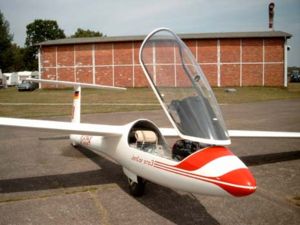PlaneSpottingWorld welcomes all new members! Please gives your ideas at the Terminal.
PZL Bielsko Jantar Standard
| SZD-48 Jantar Standard | |
| Type designation | SZD-41A SZD-48 SZD-48-2 SZD-48-3 SZD-49 |
| Competition class | Standard |
| Number built | |
| Crew | 1 |
| Length | 6.7 m |
| Height | 1.51 m |
| Cockpit width | 0.60 m |
| Cockpit height | m |
| Wingspan | 15 m |
| Wing area | 10.66 m² |
| Aspect ratio | 21.1 |
| Wing profile | NN-8 |
| Empty mass | ca. 267 kg ca. 275 kg SZD-48-3 |
| Water ballast | 150 kg 80 kg SZD-41A |
| Maximum mass | 460 kg SZD-41A 540 kg SZD-48-3 |
| Wing loading | ca. 32 - 43 kg/m² SZD-41A ca. 37 - 50.6 kg/m² SZD-48-3 |
| Maximum speed | 285 km/h (154 kts) |
| Rough air speed | 170 km/h (92 kts) |
| Stall speed | 64 km/h (34.5 kts) |
| Minimum sink rate | ca. 0.7 m/s at 75 km/h |
| Best glide ratio | ca. 39 at 95 km/h |
| Roll rate |
(-45 to +45 bank) |
The name Jantar Standard designates a family of Polish Standard Class competition sailplanes developed in the 1970's.
Poland was comparatively late in attempting an all-glassfibre design, the first SZD type in this category being the prototype Open Class SZD-38 Jantar-1 single-seater of 19m span, designed by Dipl-Ing Adam Kurbiel.
It was then developed by Dipl-Ing W. Okarmus into the SZD-41A Jantar Standard, which had the same fuselage and tail unit as the Jantar-1 but new cantilever mid-set wings of 15m span designed to OSTIV Standard Class requirements. The SZD-41A made its first flight on 3 October 1973 in the hands of A. Zientek, and the Polish team flying the type in the 1974 World Championships at Waikerie, Australia, took 3rd and 7th places in the Standard Class, while SZD-41s were placed 4th, 6th and 18th in the 1976 World Championships at Räyskäla, Finland. Altogether 160 Jantar Standards had been built by the beginning of 1980 and the type has been exported to 18 countries, including both East and West Germany, the USA and the Soviet Union.
The wings are single-spar ribless structures with foam-filled glassfibre/epoxy resin sandwich skin; no flaps are fitted and there are DFS glassfibre air brakes above and below each wing. There was originally provision for 80kg (176Ib) of water ballast in the leading edges. The fuselage is an all-glassfibre/epoxy resin shell, the centre portion having a steel tube frame on which the wings and the monowheel are mounted. The cantilever T-tail is also of glassfibre/epoxy resin, the fin being integral with the fuselage; the elevator has a spring trim. There is a retractable monowheel with a disc brake and a fixed tailwheel. The pilot sits on a semi-reclining seat under a flush-fitting two-piece canopy of which the front half is fixed and the rear section is removable for exit and entry.
The SZD-48 Jantar Standard 2 single-seater is a development of the SZD-41A also designed by Dipl-Ing W. Okarmus, and first flew in prototype form on 10 December 1977; 96 had been built by the beginning of 1980. Compared to the 41, the 48 had improved handling characteristics and larger ballast capacity. The cantilever shoulder wings have single glassfibre roving main spars and no ribs; they are covered with glassfibre/foam/glassfibre moulded skins and have plain ailerons, with duralumin air brakes in the upper and lower surfaces. There is provision for 150 litres (33 Imperial gallons) of water ballast. The glassfibre fuselage has a steel tube central frame, and the rear portion is stiffened by half-frames and ribs. The cantilever T-tail is of similar construction to the wings and has a spring trim in the elevator. There is a retractable monowheel with disc brake and a semi-recessed tailwheel. With simple modifications to the trim and speed measuring systems the SZD-48 becomes the SZD-48-2. The SZD-48-3 replaced the traditional 2-piece canopy with a modern 1-piece forward hinged canopy. Although the SZD-48-3 was outclassed by the Discus as a competition sailplane, it remained popular with sport pilots and clubs due to its rugged construction and relative low cost, and was manufactured well into the 1990's.
The SZD-49 Jantar K is an FAI 15m class version of the Jantar Standard with wing flaps; the prototype first flew on 10 October 1978.

